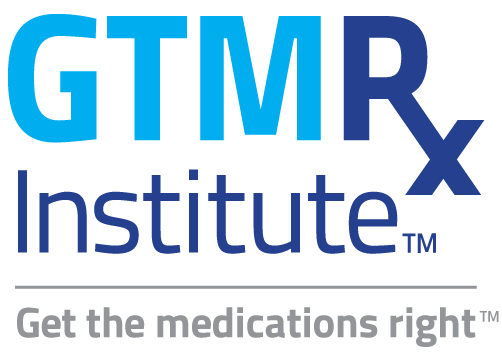
By Katherine H. Capps, Co-Founder and Executive Director, GTMRx Institute; President, Health2 Resources
September 30, 2020
Pharmacogenomics, pharmacogenetics and medication optimization
It’s been a tough few months, so let’s take on a lighter subject: names. We often hear “pharmacogenetics” and “pharmacogenomics” used interchangeably.Is that accurate? Generally speaking, yes. Both refer to the use of genetic information to guide therapeutic decisions. Both even share the PGx abbreviation.[1] One expert, writing in The Pharmacogenomics Journal, argues that pharmacogenetics “arose with studies of single genes, which had major effects on the action of particular drugs. It turned into pharmacogenomics through realization that the controls of most drug responses are multifactorial.”[2] But let’s look at the nuances.
Pharmacogenetics, simply put, is the branch of pharmacology concerned with the effect of genetic factors on reactions to drugs. It focuses on the influence of single genes on drug response. It is the field of study dealing with the variability of responses to medications due to variation in single genes.
Pharmacogenomics takes a broader view, considering the influence of an individual’s entire genome on their response to a drug therapy. It typically involves the search for variations in multiple genes that are associated with variability in drug response. Pharmacogenomic studies may also explore genetic variations among large populations to learn, for example, how different drugs affect different racial or ethnic groups.[3]
More broadly, pharmacogenomics is the study of genes and genetic variation that influence variability in a person’s response to medication. And in that light, the terms are largely interchangeable.
It’s just that pharmacogenetics predates pharmacogenomics.
Emerging, but not new
It may seem novel, but pharmacogenetics became a recognized science in the late 1950s.[4] For example, a genetic deficiency of N-acetyltransferase, an enzyme that destroyed the antituberculosis drug isoniazid, was identified in 1957. And before even that, during World War II, battlefield doctors discovered that primaquine—an antimalarial—caused hemolytic disease in Americans of African descent. Eventually, researchers identified a genetic basis.[5]
Gradual adoption
Back to the 21st century: Pharmacogenomic testing allows pharmacists and physicians to find the right medication for the individual, improving the likelihood of success. And yes, physicians have begun using PGx data to determine which medications to prescribe, but testing is routine only for certain conditions, such as HIV and some cancers.[6]
As researchers continue to identify gene variations that can affect the way a drug works, the routine use of PGx testing will increase. It has to if we are to going to optimize medication use.
PGx testing offers the clarity that allows the health professional to match the right drug and the right dose with the right patient. It optimizes treatment outcomes for patients by avoiding adverse effects and maximizing efficacy.[7]
Appropriate diagnosis and access to advanced diagnostics with companion or complementary PGx testing is essential to target correct therapy. But we aren’t there yet.
How to move forward
Even the current guideline-recommended testing isn’t routinely used to inform care decisions. We still lack the clinical tools to enable pharmacogenomics at the point of care and as part of CMM practice.
So how do we get there from here?
For one thing, we work to advance precision medicine. GTMRx’s Get the Medications Right: A Blueprint for Change Included several expert recommendations. Among them:
- Fully integrate PGx services into the pharmaceutical care process to support clinical decision making through increased availability of data. To enable this, develop tools that enable the practice of precision medicine and advanced diagnostics. For instance, develop an outline for standard operating processes for the integration of PGx testing into comprehensive medication management.
- Ensure providers and payors have secure and timely access to the information necessary to identify patients who have not achieved clinical goals of therapy.
- Optimize testing usefulness and interpretation by strengthening the relationship between the FDA and laboratories that provide PGx
- Promote precision medicine literacy among providers and patients in the context of its application to the clinical care role in optimizing medication use. Ensure everyone is aware of precision medicine’s role in care and that providers are applying it in an appropriate way for patients.
- Enable evidence-based processes and strategies that support precision medicine as a tool used in the CMM process, and enable effective standardization, awareness and interpretation.
Moving forward
PGx is complex and evolving, making it a complicated story to tell, much less understand. But understand it we must. PGx offers the potential to personalize treatment and care of individuals and optimize medication therapy. We know that each year, 275,000 die needlessly. And we know that $528.4 billion a year is wasted due to non-optimized medication use.[8],[9]PGx, by either name, advances us along the path to medication optimization. But we need to understand where we’re going and what we’re talking about when we talk about pharmacogenomics.
And when all of us—payors, physicians, pharmacists, policymakers and patients—understand its potential, we’ll end up closer to our destination.
[1] Campion DP, Dowell FJ. “Translating Pharmacogenetics and Pharmacogenomics to the Clinic: Progress in Human and Veterinary Medicine.” Front Vet Sci. 2019 Feb 11;6:22. doi: 10.3389/fvets.2019.00022. PMID: 30854372; PMCID: PMC6396708.
[2] Kalow, W. “Pharmacogenetics and pharmacogenomics: origin, status, and the hope for personalized medicine.” Pharmacogenomics J 6, 162–165 (2006). https://doi.org/10.1038/sj.tpj.6500361
[3] Stan K. Bardal BSc (Pharm), MBA, PhD, Douglas S. Martin PhD. Applied Pharmacology (2011) via Science Direct
[4] Kalow, W. Pharmacogenomics op. cit.
[5] Ibid.
[6] “Pharmacogenomics FAQ” National Human Genome Research Institute
[7] Gross T, Daniel J. “Overview of pharmacogenomic testing in clinical practice.” Ment Health Clin. 2018;8(5):235–241. Published 2018 Aug 30. doi:10.9740/mhc.2018.09.235
[8] Cutler DM, Everett W. “Thinking outside the pillbox: medication adherence as a priority for health care reform.” N Engl J Med. 2010;362(17):1553-1555
[9] Watanabe J, et al. “Cost of Prescription Drug–Related Morbidity and Mortality.” Annals of Pharmacotherapy, March 26, 2018. journals.sagepub.com/eprint/ic2iH2maTdI5zfN5iUay/full

